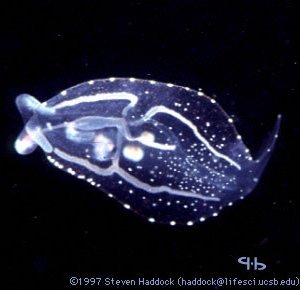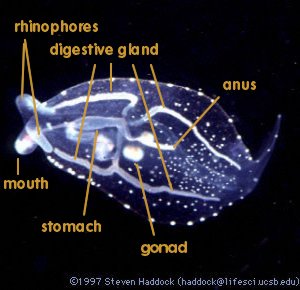

Phylliroe bucephalum
Peron & Lesueur, 1810
Order: NUDIBRANCHIA
Suborder: DENDRONOTINA
Family: Phylliroidae
DISTRIBUTION
Planktonic nudibranchs apparently found throughout the world
PHOTO
Left lateral view of animal, approx 8 cm long. Photo: Steve Haddock. Lower photo, modified and labelled by Bill Rudman.
See Steve's Bioluminescence Site: http://lifesci.ucsb.edu/~biolum/
Highly modified planktonic nudibranch. The juveniles have been reported to parasitise the medusae of the cnidarian Zanclea, attaching to the inside of the bell, on which they feed and remain until adulthood. As adults they are free-living, feeding on Zanclea as well as other medusae and plankton, including Oikopleura. Their basic anatomy can be seen through their transparent body wall. The two dorsal lobes of the digestive gland are modified into two dorsal tubular structures, and the posterior lobe becomes two ventral tubular lobes. The short intestine lead to the anus which opens midway down the right side of the body. Phylliroe is one of the few nudibranchs to exhibit bioluminescence.
Two mispellings of the generic name: Phyllirhoe Oken, 1815 and Phyllirrhoe Menke, 1821 entered the literature very early on and unfortunately are still used today.
Reference:
• Lalli, C.M. & Gilmer, R.W. (1989). Pelagic Snails. The biology of holoplanktonic gastropod mollusks. Stanford: Stanford University Press.
Rudman, W.B., 2000 (August 9) Phylliroe bucephalum Peron & Lesueur, 1810. [In] Sea Slug Forum. Australian Museum, Sydney. Available from http://www.seaslugforum.net/factsheet/phyllir
Related messages
-
Another Phylliroe photo
From: Steve Haddock, March 18, 2003 -
Bioluminescence in Phylliroe
From: Steven Haddock, August 10, 2000 -
Phylliroe
From: Clay Bryce, November 18, 1998
